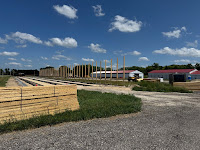|
Element |
Interurban Car |
City Car |
Bus |
|
Roof |
Atlas Yellow |
Pigskin Brown |
Straw |
|
Letterboard |
Apple Green |
Lemon Yellow |
Medium Green |
|
Sash Belt |
White |
White |
Pigskin Brown |
|
Wide Stripe |
Pigskin Brown |
Light Blue |
Double Deep Orange |
|
Body |
Double Deep Orange |
Bright Red |
Pigskin Brown |
|
Skirt |
Medium Green |
Deep Red |
Dark Green |
News and views of progress at the Illinois Railway Museum
Sunday, June 29, 2025
Finding Their Niche
Posted by
Frank Hicks
at
5:00 PM
0
comments
![]()
Friday, June 27, 2025
GB&W 109 Update
Thanks to our intrepid cub reporter Gregg Wolfersheim, who sends along this update of progress on Green Bay & Western wood coach 109, currently being worked on in the Barn 4 Electric Car Shop.
Posted by
Frank Hicks
at
10:27 PM
1 comments
![]()
Labels: GBW 109
Thursday, June 26, 2025
North Shore Album, Part 3 - MD Cars and the 354
Thanks again to Art Peterson for more pictures of IRM cars in service, from the Krambles-Peterson Collection.
North Shore 213 is the only one of the original order of MD cars that was preserved.
Here it is at Wilson c. 1925 in a portrait by A.F. Scholz.
The MD cars were also used for clearing snow from the streets of Milwaukee. We have several good views of this process:
Posted by
Randall Hicks
at
3:00 PM
1 comments
![]()
Labels: Krambles-Peterson Archive, North Shore, Permanent Features
Wednesday, June 25, 2025
North Shore Album, Part 2
 |
| The 714 at Highwood on Jan. 1st, 1946. Photo by Tom Desnoyers. |
Posted by
Randall Hicks
at
4:30 PM
0
comments
![]()
Labels: Krambles-Peterson Archive, North Shore, Permanent Features
Tuesday, June 24, 2025
North Shore Album, Part 1
Thanks to Art Peterson for sending us more pictures of IRM cars on their original lines from the Krambles-Peterson archives. Time to start on the North Shore Line, with cars 160, 251, and 253.
160
Northbound at Glenview on Dec. 31, 1960.
Posted by
Randall Hicks
at
7:15 PM
0
comments
![]()
Labels: Krambles-Peterson Archive, North Shore, Permanent Features
Monday, June 23, 2025
Sunday Scorcher
Frank writes...
Thanks to Gregg Wolfersheim and Keith Letsche, who ran the 319 in 50th Avenue Shuttle service all day.
When Nathan and Drew brought the D13 back to Yard 7, the first order of business was to unload the picnic tables being used for seating and reload several pallets of spare parts that normally live in the dump section to keep them inside the barn and out of the weather. Here, Nathan has dropped the side of the dump section. Although the tilt mechanism for the dump body doesn't work, the doors do drop open and can be closed by a pneumatic spool that pulls up cables at both ends of the dump section.
Voilà deux. With a second coat of maroon on the belt rail stripes, the masking tape could come off. Of course, this is only about a quarter of the car - next up is masking and painting the left side and the rear half of the door side - but it's progress, and it gives an idea of how this livery will look when complete. I also painted the drip rail under the standee windows on this side of the car maroon.
And in exciting Buildings & Grounds news, the posts have started going up on Barn 15! The trusses are already staged and can be seen in the foreground.
And it looks like the property improvement work at the west end of Yard 5, in front of the office, is just about done. The nice new asphalt, "sidewalk" for the benches, and bollards are all installed.
Posted by
Frank Hicks
at
10:20 PM
0
comments
![]()
Labels: Shaker Heights 63
Sunday, June 22, 2025
Illinois Terminal: Suburban, Branch Line and Freight Equipment
Posted by
Frank Hicks
at
5:00 PM
0
comments
![]()
Labels: Illinois Terminal, Krambles-Peterson Archive, Permanent Features

























































